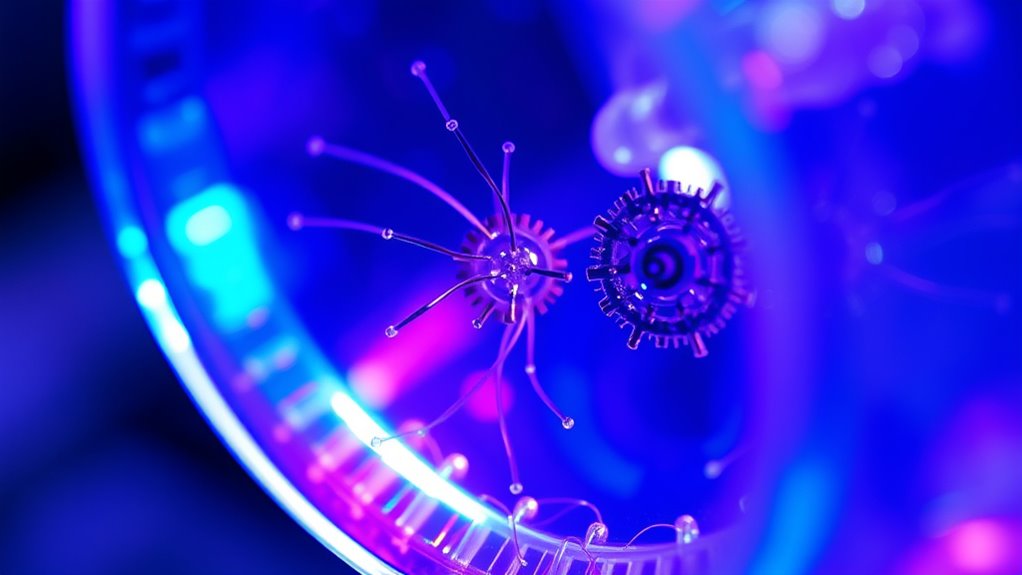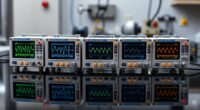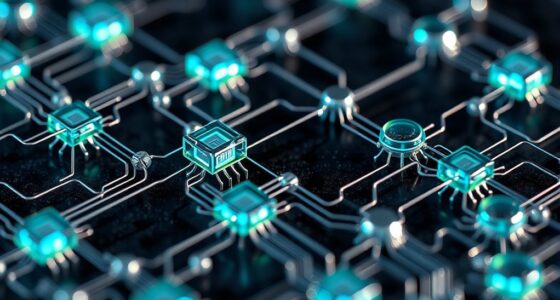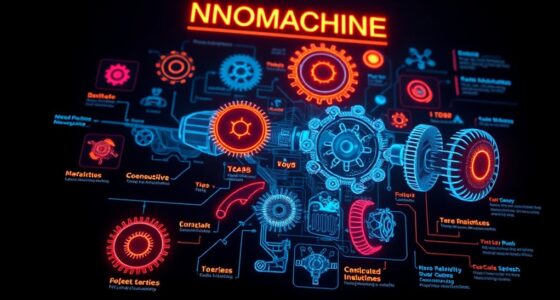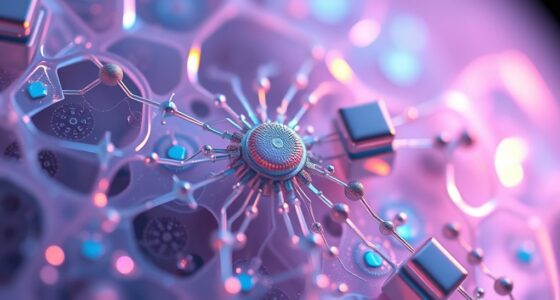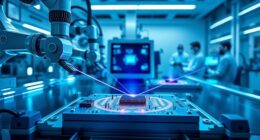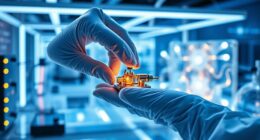Enzyme-powered nanomachines are innovative biohybrid systems that use biological catalysts to perform precise tasks at the nanoscale, such as targeted drug delivery, pollutant breakdown, and industrial catalysis. They combine enzymes with nanomaterials to create efficient, stable machines capable of operating in complex environments. These systems are advancing medicine, environmental cleanup, and manufacturing. To discover how these tiny machines are transforming various fields and what challenges lie ahead, keep exploring this exciting area.
Key Takeaways
- Enzyme-powered nanomachines utilize biological catalysts integrated with nanomaterials to perform precise nanoscale tasks.
- They are designed for applications like targeted drug delivery, biosensing, and environmental remediation.
- Advances in assembly techniques and enzyme stabilization enhance their efficiency and durability in complex environments.
- These biohybrid systems offer sustainable solutions by degrading pollutants and enabling eco-friendly industrial processes.
- Challenges include scalability, enzyme stability, and regulatory considerations for widespread industrial and medical use.
The Fundamentals of Enzyme-Driven Nanomachines
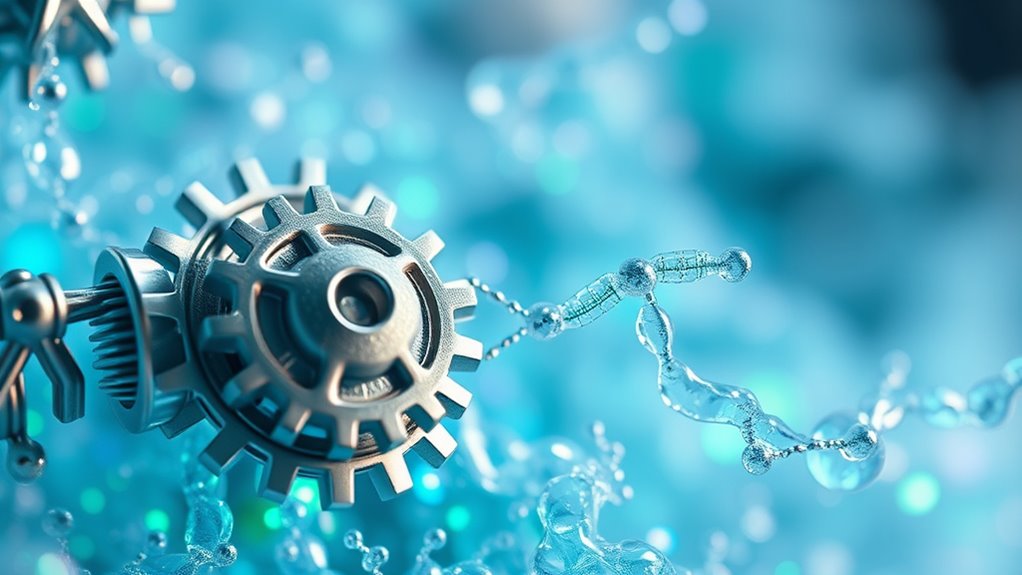
Enzyme-driven nanomachines harness the remarkable catalytic abilities of enzymes to perform precise molecular tasks at the nanoscale. By understanding enzyme kinetics, you grasp how these biological catalysts speed up reactions and achieve specificity. The catalytic mechanisms involve the enzyme’s active site, where substrate molecules bind and undergo transformation, often through conformational changes. These mechanisms guarantee that reactions occur efficiently and selectively, essential for nanomachine function. You’ll see how enzyme kinetics, such as Michaelis-Menten dynamics, help optimize these processes for nanoscale applications. This knowledge allows you to manipulate enzyme activity, tailoring nanomachines for specific tasks. Overall, the core principles of enzyme kinetics and catalytic mechanisms underpin the design and operation of biohybrid nanomachines, enabling precise control at an incredibly small scale. Understanding enzyme regulation further enhances the ability to fine-tune these systems for diverse applications.
Designing Biohybrid Nanostructures

Building biohybrid nanostructures involves integrating enzymes with various nanomaterials to create functional systems capable of specific tasks. To achieve this, you focus on optimizing enzyme stability, guaranteeing enzymes retain activity within the nanostructure. You select suitable nanomaterials—such as nanoparticles, nanowires, or nanotubes—that support enzyme attachment and facilitate efficient nanostructure assembly. Precise control over the assembly process is critical; you often employ techniques like layer-by-layer assembly, self-assembly, or surface functionalization to ensure proper orientation and integration. Additionally, incorporating mindfulness practices during the design process can enhance focus and precision. By fine-tuning these parameters, you create stable, efficient biohybrid systems. This strategic design enhances enzyme performance, durability, and functionality, forming the foundation for advanced biohybrid nanomachines that can operate reliably in various environments.
Applications in Medicine and Healthcare
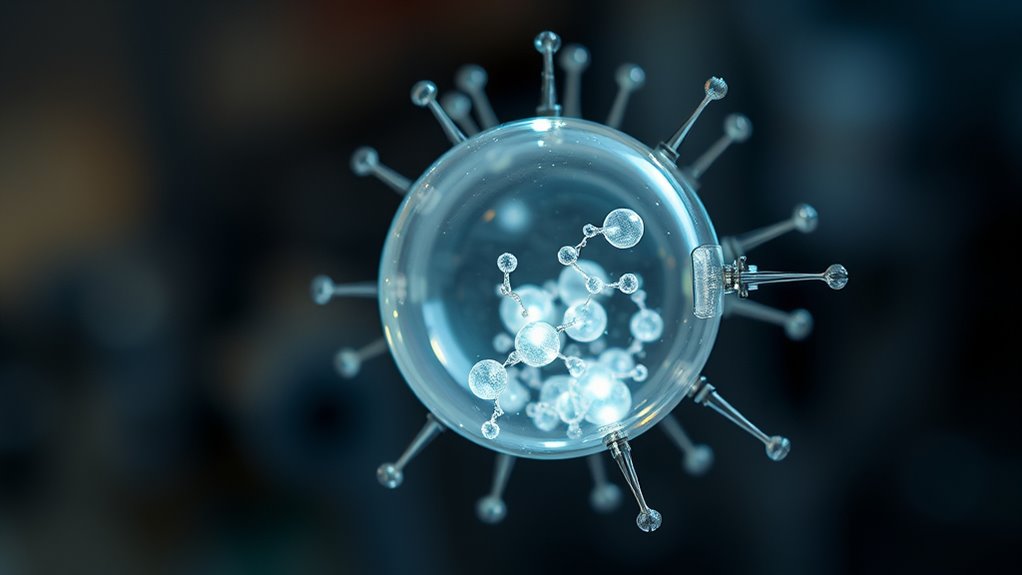
Biohybrid enzyme nanomachines are revolutionizing medicine by enabling targeted drug delivery, so treatments can reach precise locations in the body. They also serve as advanced diagnostic tools, providing quick and accurate health assessments. Additionally, enzyme-driven therapies offer new ways to treat diseases more effectively and with fewer side effects. Incorporating investment strategies into the development of these technologies can facilitate their advancement and widespread adoption.
Targeted Drug Delivery
Targeted drug delivery has revolutionized medicine by allowing treatments to focus precisely on affected tissues, minimizing side effects and enhancing effectiveness. Enzyme stability plays a pivotal role in ensuring nanomachines function reliably within the body. Biohybrid systems enable the assembly of nanomachines tailored for specific delivery tasks, improving precision. These systems can navigate complex biological environments, releasing drugs only at the target site. Key factors include:
- Maintaining enzyme stability under physiological conditions
- Optimizing nanomachine assembly for targeted transport
- Enhancing biocompatibility to reduce immune response
- Improving control over drug release timing and location
Precision Diagnostic Tools
Precision diagnostic tools are transforming healthcare by enabling rapid, accurate detection of diseases at their earliest stages. By leveraging enzyme optimization, you can enhance the specificity and sensitivity of these tools, making early diagnosis more reliable. Nanomachine fabrication plays a vital role by creating tiny, highly responsive devices capable of detecting biomarkers at minute concentrations. These biohybrid systems can identify pathogens, proteins, or genetic mutations quickly, providing immediate insights into health conditions. You can design nanomachines that combine enzymes with nanomaterials for improved stability and efficient signal transduction. As a result, you gain portable, highly precise diagnostics that can be used bedside or in remote areas, markedly improving patient outcomes through early intervention. This integration of enzyme engineering and nanofabrication is revolutionizing disease detection.
Enzyme-Driven Therapy
Enzyme-driven therapy has emerged as a promising approach to treat various medical conditions by harnessing the catalytic power of enzymes to perform targeted interventions. Advances in enzyme evolution allow you to develop highly specific enzymes tailored for precise therapeutic actions. Nanomachine scalability ensures these biohybrid systems can be produced efficiently for widespread medical use. This approach enables you to:
- Enhance drug delivery precision
- Minimize side effects
- Enable personalized treatments
- Improve treatment response times
Environmental Remediation With Enzyme Nanomachines
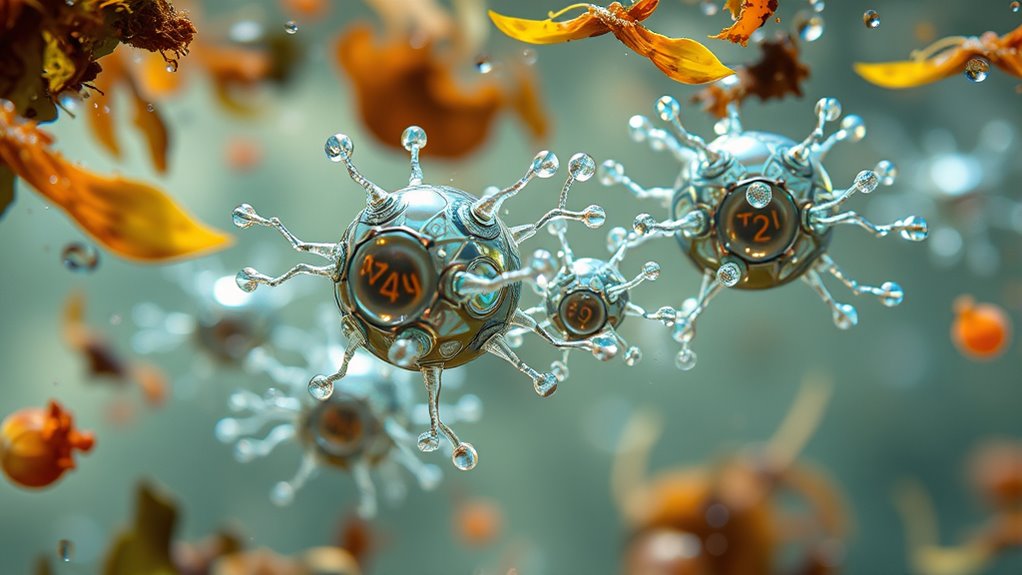
Have you ever wondered how nanotechnology can help clean up environmental pollutants more efficiently? Enzyme nanomachines offer promising solutions for environmental remediation by targeting contaminants from industrial agriculture and food processing. These biohybrid systems can break down pesticides, fertilizers, and waste products directly at pollution sites, reducing harmful residues. Because enzymes are highly specific, they can degrade pollutants without affecting surrounding ecosystems. Incorporating enzyme nanomachines into filtration systems or in situ treatments enhances cleanup speed and effectiveness. Their stability and reusability mean you can deploy them repeatedly, making the process more sustainable. As a result, these nanomachines help minimize environmental impact, protect water sources, and promote healthier ecosystems—showing how advanced biohybrid systems are transforming pollution control.
Challenges and Future Perspectives
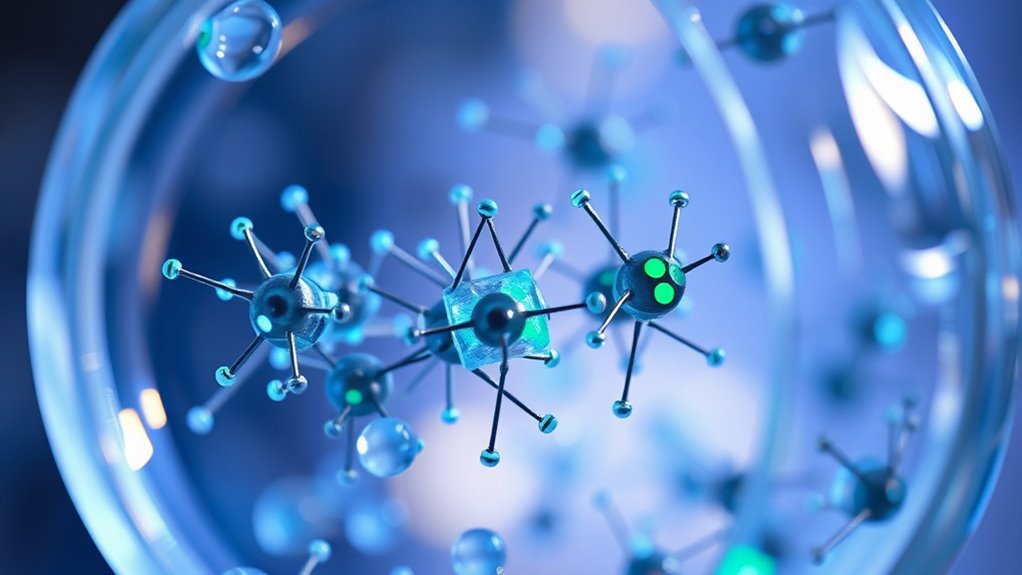
Despite the promising potential of biohybrid enzyme nanomachines in environmental remediation, several challenges hinder their widespread adoption. Scalability issues remain a significant barrier, as producing these systems at industrial levels requires overcoming complex manufacturing and stability concerns. Ethical considerations also arise around the use of genetically engineered components and potential environmental impacts. Additionally, you must address:
Scaling up biohybrid enzyme nanomachines faces manufacturing, stability, and ethical challenges for wider environmental impact.
- Ensuring consistent enzyme activity under diverse conditions
- Preventing unintended ecological effects
- Developing cost-effective production methods
- Steering regulatory frameworks and public acceptance
These hurdles demand innovative solutions to realize future applications fully. While ongoing research offers hope, tackling scalability issues and ethical considerations is vital for transforming enzyme-powered nanomachines into reliable, responsible tools for environmental and biomedical uses. Ulta Beauty Store Hours
Pioneering Research and Emerging Innovations
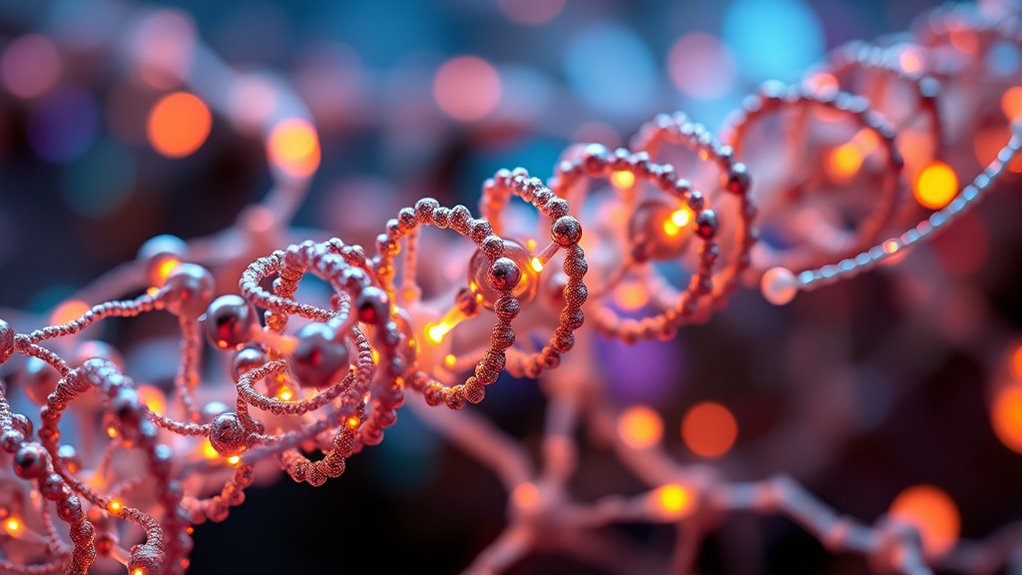
You’ll see how cutting-edge enzyme designs are transforming biohybrid nanomachines, opening new possibilities for precision and efficiency. Researchers are developing innovative approaches that push the boundaries of what these systems can achieve. These emerging innovations hint at exciting future applications across medicine, environmental cleanup, and beyond. Advances in sound recording techniques are also playing a crucial role in optimizing the development and testing of these biohybrid systems.
Cutting-Edge Enzyme Designs
Recent advances in biohybrid enzyme nanomachines showcase innovative designs that push the boundaries of catalytic efficiency and specificity. Researchers are developing enzyme modifications and engineered active sites to maximize enzyme stability within nanomachines, ensuring durability under operational conditions. These innovations also focus on nanomachine fabrication techniques that tightly integrate enzymes with nanostructures, enhancing functional performance. You’ll find emerging strategies include:
- Tailored enzyme immobilization techniques for improved stability
- Fusion proteins to increase robustness in harsh environments
- Modular designs allowing customizable catalytic functions
- Use of synthetic scaffolds to optimize spatial enzyme arrangements
These cutting-edge enzyme designs enable more reliable, efficient biohybrid systems, expanding their potential for practical applications. The focus remains on refining enzyme stability and nanomachine fabrication, making these innovations pivotal for future developments.
Future Biohybrid Applications
Emerging research in biohybrid enzyme nanomachines is paving the way for transformative applications across medicine, environmental management, and industrial processing. Future innovations include designing synthetic enzymes tailored for specific tasks, enhancing nanomachine scalability, and improving efficiency. These advancements could enable targeted drug delivery, pollutant breakdown, and sustainable manufacturing. As research progresses, you’ll see hybrid systems that adapt to various environments, offering smarter solutions. The table below highlights some promising areas:
| Application Area | Key Innovation |
|---|---|
| Medicine | Precision drug delivery |
| Environment | Rapid pollutant detoxification |
| Industry | Eco-friendly catalysis |
| Detection | Sensitive biosensing |
These emerging applications promise to revolutionize multiple sectors, unbar the full potential of biohybrid systems.
Frequently Asked Questions
How Do Enzyme Nanomachines Compare to Traditional Synthetic Nanomachines?
You’ll find enzyme nanomachines outperform traditional synthetic nanomachines in biocompatibility advantages and energy efficiency. These biohybrid systems work seamlessly within biological environments, reducing toxicity risks. They utilize natural enzymes, making them more energy-efficient because they harness biochemical energy directly. Unlike synthetic options, enzyme nanomachines adapt better to complex biological tasks, opening new possibilities for medical and environmental applications with safer, more sustainable operation.
What Are the Safety Considerations for Deploying Biohybrid Nanomachines in Humans?
When deploying biohybrid nanomachines in humans, you need to prioritize biocompatibility assessment to guarantee they don’t cause adverse reactions. Be aware of regulatory challenges, as these devices often face strict approval processes due to their complex nature. You should also consider potential immune responses, long-term stability, and precise control mechanisms. Addressing these safety considerations helps protect patients and facilitates smoother regulatory approval.
Can Enzyme-Powered Nanomachines Operate in Extreme Environmental Conditions?
Yes, enzyme-powered nanomachines can operate in extreme conditions, but their efficiency depends on enzyme stability. You need to make certain the enzymes used are stable under the specific environment, like high temperatures or pH levels. Researchers often modify enzymes or select naturally robust ones to maintain activity. So, with proper design, these nanomachines can function effectively even in challenging environments.
What Are the Economic Implications of Producing Enzyme Nanomachines at Scale?
Producing enzyme nanomachines at scale can considerably lower costs through automation and optimized manufacturing processes, leading to cost reduction. This affordability boosts market expansion by making these biohybrid systems accessible across various industries, such as healthcare and environmental remediation. As production becomes more efficient, you’ll find more opportunities for innovation and commercialization, ultimately driving economic growth and encouraging widespread adoption of enzyme-powered nanomachines.
How Do Enzyme Nanomachines Communicate or Coordinate With Each Other?
Sure, these tiny marvels communicate through molecular signaling, surprisingly sophisticated for their size. You might think they’d be lone wolves, but these nanomachines engage in cooperative interactions, exchanging signals just like a well-oiled team. They coordinate actions seamlessly, ensuring efficient function. It’s ironic how such minuscule entities mimic complex biological communication, proving that even at the nanoscale, teamwork isn’t just for humans.
Conclusion
Imagine enzyme-powered nanomachines as tiny, relentless explorers carving new paths in medicine and the environment. Their biohybrid nature acts as a bridge between biology and technology, symbolizing hope and innovation. As you witness their potential unfold, remember each tiny machine is a beacon guiding us toward a cleaner, healthier future. Embrace this frontier, where science’s spark ignites a revolution—your role in shaping this dawn is more crucial than ever.
